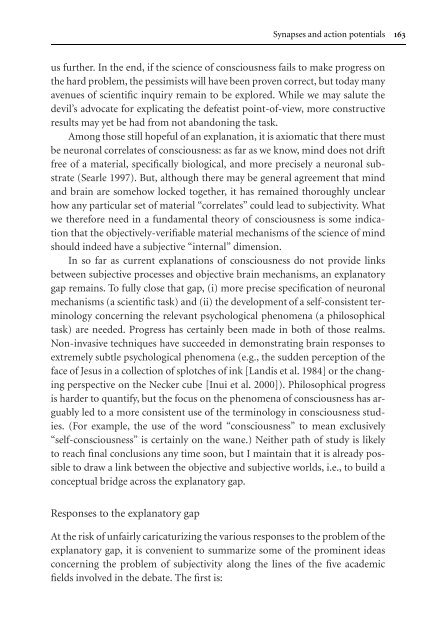Tone of Voice and Mind : The Connections between Intonation ...
Tone of Voice and Mind : The Connections between Intonation ...
Tone of Voice and Mind : The Connections between Intonation ...
Create successful ePaper yourself
Turn your PDF publications into a flip-book with our unique Google optimized e-Paper software.
Synapses <strong>and</strong> action potentials 163<br />
us further. In the end, if the science <strong>of</strong> consciousness fails to make progress on<br />
the hard problem, the pessimists will have been proven correct, but today many<br />
avenues <strong>of</strong> scientific inquiry remain to be explored. While we may salute the<br />
devil’s advocate for explicating the defeatist point-<strong>of</strong>-view, more constructive<br />
results may yet be had from not ab<strong>and</strong>oning the task.<br />
Among those still hopeful <strong>of</strong> an explanation, it is axiomatic that there must<br />
be neuronal correlates <strong>of</strong> consciousness: as far as we know, mind does not drift<br />
free <strong>of</strong> a material, specifically biological, <strong>and</strong> more precisely a neuronal substrate<br />
(Searle 1997). But, although there may be general agreement that mind<br />
<strong>and</strong> brain are somehow locked together, it has remained thoroughly unclear<br />
how any particular set <strong>of</strong> material “correlates” couldleadtosubjectivity.What<br />
we therefore need in a fundamental theory <strong>of</strong> consciousness is some indication<br />
that the objectively-verifiable material mechanisms <strong>of</strong> the science <strong>of</strong> mind<br />
should indeed have a subjective “internal” dimension.<br />
In so far as current explanations <strong>of</strong> consciousness do not provide links<br />
<strong>between</strong> subjective processes <strong>and</strong> objective brain mechanisms, an explanatory<br />
gap remains. To fully close that gap, (i) more precise specification <strong>of</strong> neuronal<br />
mechanisms (a scientific task) <strong>and</strong> (ii) the development <strong>of</strong> a self-consistent terminology<br />
concerning the relevant psychological phenomena (a philosophical<br />
task) are needed. Progress has certainly been made in both <strong>of</strong> those realms.<br />
Non-invasive techniques have succeeded in demonstrating brain responses to<br />
extremely subtle psychological phenomena (e.g., the sudden perception <strong>of</strong> the<br />
face <strong>of</strong> Jesus in a collection <strong>of</strong> splotches <strong>of</strong> ink [L<strong>and</strong>is et al. 1984] or the changing<br />
perspective on the Necker cube [Inui et al. 2000]). Philosophical progress<br />
is harder to quantify, but the focus on the phenomena <strong>of</strong> consciousness has arguably<br />
led to a more consistent use <strong>of</strong> the terminology in consciousness studies.<br />
(For example, the use <strong>of</strong> the word “consciousness” to mean exclusively<br />
“self-consciousness” is certainly on the wane.) Neither path <strong>of</strong> study is likely<br />
to reach final conclusions any time soon, but I maintain that it is already possible<br />
to draw a link <strong>between</strong> the objective <strong>and</strong> subjective worlds, i.e., to build a<br />
conceptual bridge across the explanatory gap.<br />
Responses to the explanatory gap<br />
At the risk <strong>of</strong> unfairly caricaturizing the various responses to the problem <strong>of</strong> the<br />
explanatory gap, it is convenient to summarize some <strong>of</strong> the prominent ideas<br />
concerning the problem <strong>of</strong> subjectivity along the lines <strong>of</strong> the five academic<br />
fields involved in the debate. <strong>The</strong> first is:


